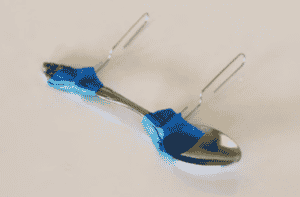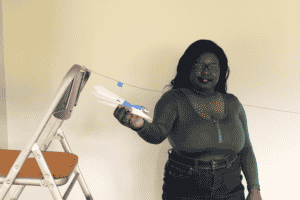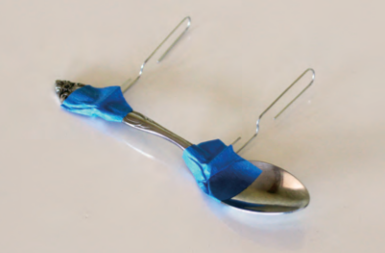Overview
STEM careers
Time
Materials
Per Class:
|
Per Pair of Students:
|
Instructions
PREPARATION
- Set up a zipline, between 15–20 feet long, for planes to slide down. Make one end 2–3 feet higher than the other by attaching the high end to a chair or other solid object and the lower end to a heavy object such as a stool or stack of books. Check for tautness.
- Prepare the spoons, which will give the airplanes weight and structure. Note: all spoons should be the same weight and shape for comparable testing.

- For each spoon, bend 2 paper clips into an S shape to be hangers.
- Position one paper clip near the scoop end and the other near the handle end. Hook the narrow end of each paper clip around the spoon and tape in place. Make sure paper clips are in the same position on each spoon.
- As a test, hang a spoon on the zipline and make sure it moves at 3 seconds per 10 feet or 5 seconds per 20 feet. Adjust as needed by tightening the zipline or bending the paper clips to hang at right angles to the thread.
- Ask students how planes contribute to climate change. Questions They need a lot of fuel, but why? One reason is drag, the aerodynamic force that opposes an aircraft’s motion through air. Demonstrate drag by attaching a flat sheet of paper perpendicular to the spoon so that the paper faces down the zipline. Time it as it slides down the zipline. Gravity—rather than fuel—causes the spoon to move, but air pushes against the paper, causing drag and slowing it down.
- The challenge is to build a paper airplane that will slide down the zipline the fastest. The less drag, the faster the plane. Give students these constraints:
- The design has to use one full sheet of paper and have wings and a body, like an airplane.
- The design can’t use anything besides the spoon to make it heavier.
- Only the two paper clips can hook to the zipline.

- Place students in pairs. Have them begin by sketching some design ideas. Distribute materials and instruct pairs to make and test different designs, which they can try out on the zipline. Have them pick their best design for the class contest.
- Use the timer to test each design; students can release their airplanes twice and use their best time. Write down each time on the board. As time allows, discuss the winning designs and what could make them even faster.
Guiding questions
- What role do you think drag has on the plane’s performance?
- Would shaping the wing tips to poke up or down make the plane any faster?
- What Shape would make air flow over and under, rather than slamming into, the plane’s nose?
- Does your plane need a rudder on the tail? Why or why not?
Major funding by the Lemelson Foundation. Project funding is provided by United Engineering Foundation (UEF), the National Council of Examiners for Engineering and Surveying (NCEES), and the UL Innovative Education Award.


0 Comments